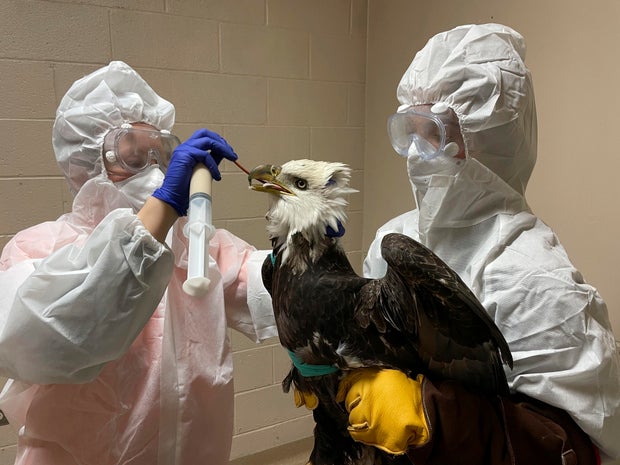▶ Watch Video: Lead from ammunition left behind by hunters posing risk for bald eagles
The Wisconsin Department of Natural Resources (DNR) is investigating the death of a bald eagle who appears to have been shot, officials said Tuesday.
The eagle was brought to the Wisconsin Humane Society Wildlife Rehabilitation Center by a DNR conservation warden on Dec. 7, after it was found in the city of Franklin, a suburb of Milwaukee, the Humane Society said in a press release. The bird was unable to fly because of a fractured humerus bone in his wing, and a severe wound in the wing as well, the Humane Society said. The tip of his beak was also broken.

Exam results from a pet hospital — including blood work that showed an elevated level of lead toxicity — led to suspicion that the fracture resulted from a gunshot, the Humane Society reported.
A lifesaving surgery on Dec. 8 stabilized the eagle, but a second surgery on Dec. 12 which was meant to stabilize the fracture — and further treat the bird’s injuries — led to cardiac arrest, the Humane Society said. The bald eagle did not respond to lifesaving efforts, including CPR, and he died.
“We cannot thank the community enough for the compassion and support shown for this special patient while our team of wildlife rehabilitators worked tirelessly over the past several days trying to save him,” the Humane Society said its release announcing the bird’s death.
“We are mourning the loss of this eagle alongside our community,” the Humane Society added.
Anyone with information about how the bird may have been injured is asked to contact the Wisconsin DNR.
Bald eagles were once endangered, although they were removed from the endangered species list in 2007 because of their increasing population. However, they still remain under federal protection. The 1940 Bald and Golden Eagle Protection Act, as well as the 1918 Migratory Bird Treaty Act, protect eagles and their nests.
Under the Bald and Golden Eagle Protection Act, wounding or killing an eagle can result in a fine of $100,000 and one year in prison for a first offense, according to the U.S. Fish and Wildlife Service. A second violation of the act is considered a felony, and the penalties “increase substantially.”







